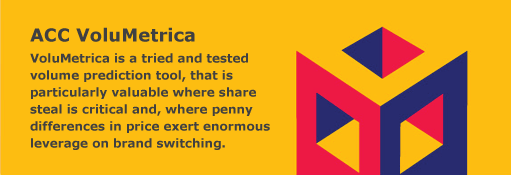VoluMetrica is a tried and tested volume prediction tool, that is particularly valuable where share steal is critical and, where penny differences in price exert enormous leverage on brand switching.
VoluMetrica was developed to address six particular criticisms of other volume prediction techniques.
That volume forecasts often overestimate market potential and to correct this, new products need to be assessed in the context of their competitive set. Even products that are believed to break new ground must be demonstrated to do just that if correct volume prediction is to be achieved.
That consumers in research often ’see through’ artificial buying situations with ease and, while they may ’play the game’, the predictive value of the data derived in this way is doubtful in the extreme.
That volumetric methods are boring and tedious for respondents and interviewers alike. The resulting loss in concentration undermines the quality of the response.
That many techniques require complex administration at the point of interview and elsewhere, the opportunity for interviewer error is ever present and cannot be corrected later.
That few volumetric models attempt to measure consumer wearout with products; that consumers switch brands and products because they fancy a change or, take a policy decision not to buy, such as for ethical
preference.
That full scale volumetric prediction techniques may see little change out of ’100,000 per market.
In VoluMetrica, ACC’s primary objectives were to make the process cheaper, more flexible and tailored to fit with the type of product or market research that is likely to be taking place in any event at the same time.
In this way field work is never duplicated and, instead of a single monolithic figure calculated at the end of the development project, volume estimates can be generated early and are regularly updated as a project progresses.
Most critically, VoluMetrica was designed to be:
Additive not multiplicative, so small errors in estimates are not compounded by multiplying them together in the computation.
Then accounts for:
The fundamental repeat purchase cycle for the market.
The repeat purchase frequency for individual brands.
The frequency of brand switching.

